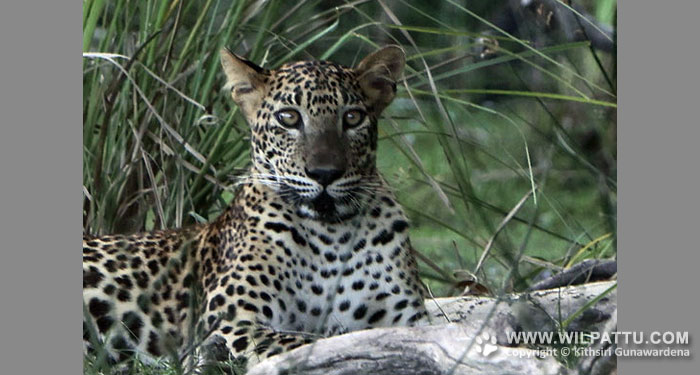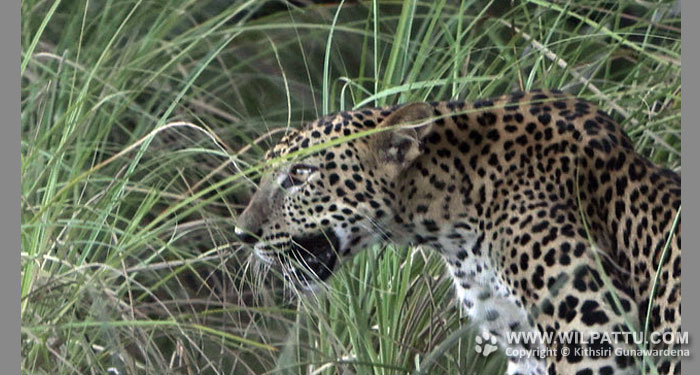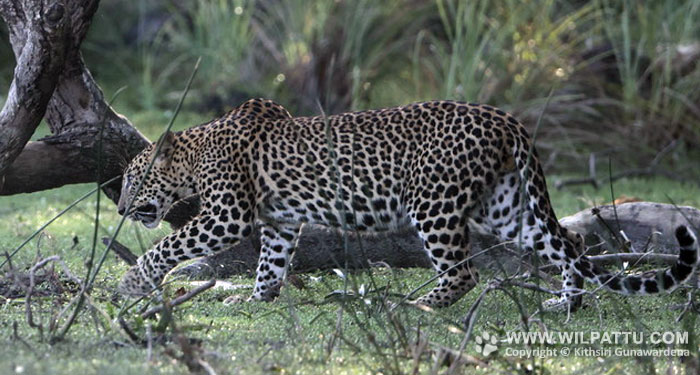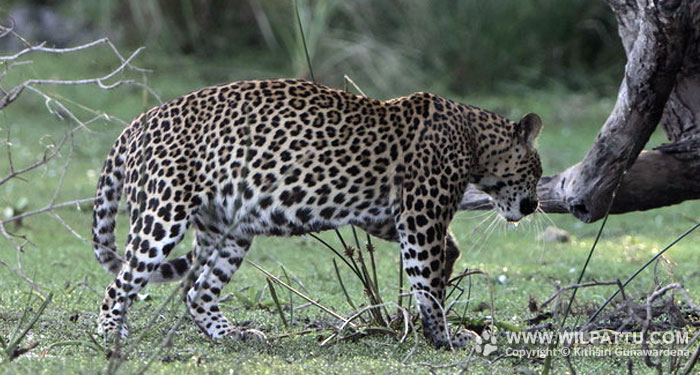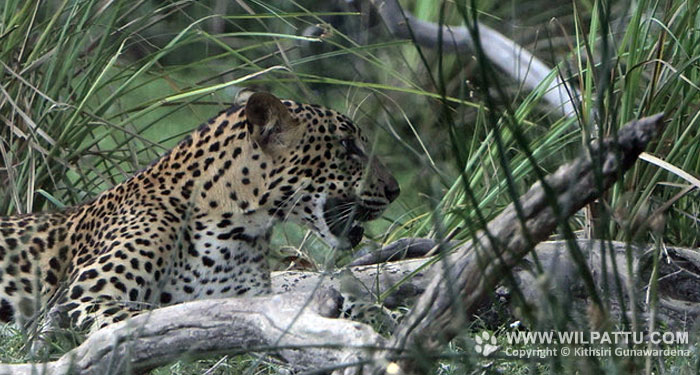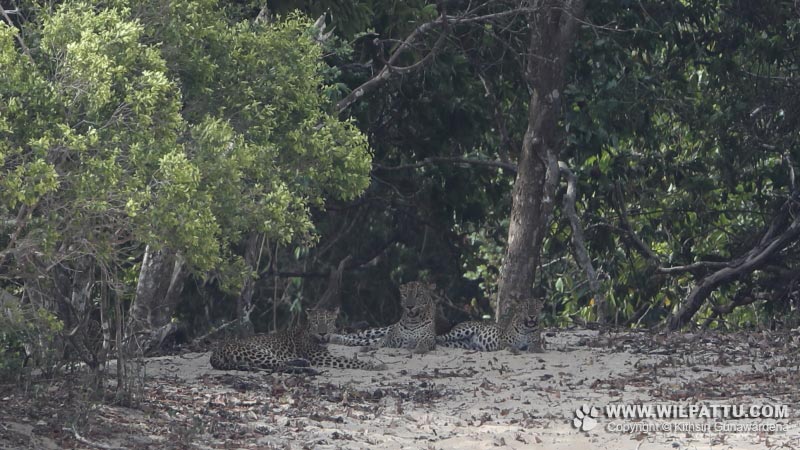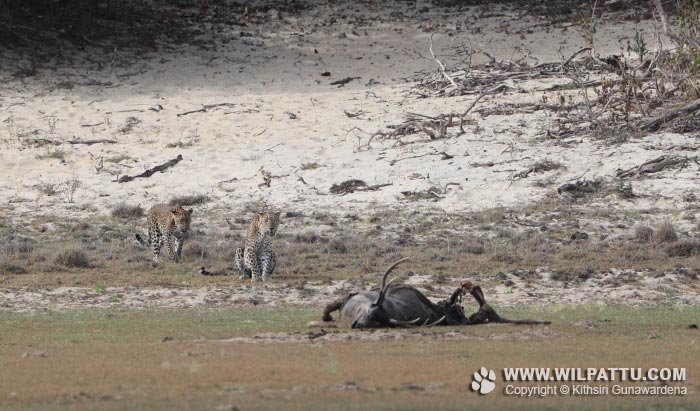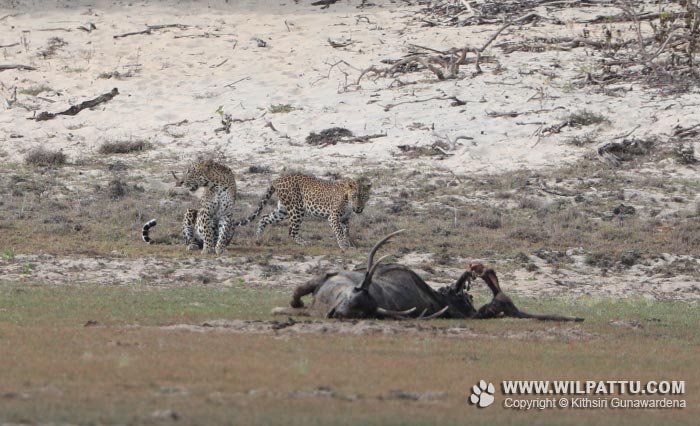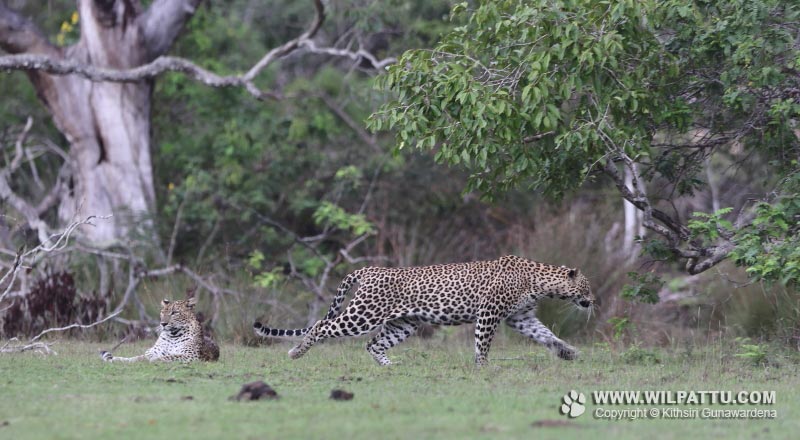-
30th September 2023 at 4.18pm one leopard at Kumbuk Wila pitiya. N 08.42109, E 080.01005
It was a young male and was lying at the edge of the forest across the open glade. I managed to get a few images despite the heavy drizzle. Within a few minutes the cat moved into the forest. Upon examining its spot pattern, I noted that this is Kumbuk Wila Male 1 (KWMC 1), one of the two male cubs of the famed female Kumbuk Wila Female 2 (KWFC 2) popularly referred to as “Cleopatra” by the safari jeep drivers.
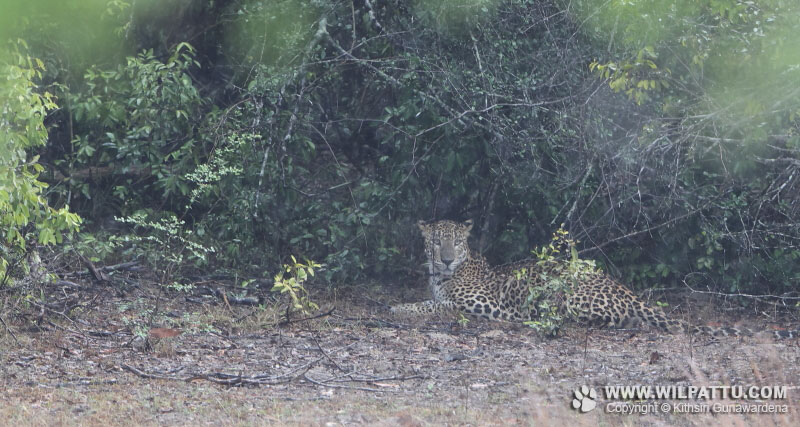
-
1st July 2023 at 2.45pm 3 leopards at the Sambhur kill at Kudapatessa. N 08.43159, E 079.99229
I observed a dead Sambhur antler at Kudapatessa in the morning during the last day of my previous visit to the park on the 27th of June 2023. The jeep drivers who occupied the park bungalows confirmed that they had not observed this carcass the previous evening. There were no leopard sightings associated with this carcass or the entire day.
I received information of leopard sightings at this kill from the 28th and was thrilled to have spotted two leopards, and adult male and a younger male, sleeping under the shade of a tree at the edge of the forest. After some time, a third female leopard walked up to the adult male and was enticing him to mate with her by engaging in typical premating behaviour by rubbing her body against him and sitting on his body ect. The big male mounted her and mated with her once. Thereafter she moved back in to the jungle. Around 4.15pm The younger male walked down the sand rimmed edge of the villu, and the female followed him up to the kill. But while the male started to feed on the kill the female turned back and walked back to the big male. After feeding for about 10 minutes the younger male walked back to where the big male and lied down beside him. There was no aggression expressed by the big male or the female towards the younger male.
Later upon examining the spot patterns of these leopards I was happy to note that the big male was Nelum Wila Male 5 (NWMC 5), the dominant male of the area. The female is Manikrala Uraniya Female 1 (MRUF 1), who is referred to as Kuruttupandi female by the jeep drivers and who successfully raised one female cub with her first litter. The younger male is Kumbuk Wila Male 1 (KWMC 1), one of the first litter male cubs of Kumbuk Wila Female 1 (KWFC 1), popularly known as Cleopatra. It is quite likely that this big male is the father of this cub.
-
24th June 2023 at 9.29am one leopard between Down Hall pitiya and Mana Wila sand patch. N 08.46780, E 079.99026
I heard the alarm calls of a troop of Grey Langur as I drove passt Down Hall pitiya towards Mana Wila. The behaviour of the langurs indicated that the leopard had moved off the road and it was quite close. I stopped the vehicle and looked but failed to spot any leopard. Thus, decided to drive down to the sand patch and come back to give the leopard some time. Often when a leopard had moved off the road giving some time results in the curious cat moving back in to the open. When I arrived at the spot the leopard was by the side of the road. I managed to get a few images before he moved back into the forest amidst the frantic alarm calls of the langurs. Its spot pattern revealed that it is Kumbuk Wila Male 2 (KWMC 2), one of the first litter male cubs of Kumbuk Wila Female 2 (KWFC 2) popularly referred to as Cleopatra by the jeep drivers. My previous sighting of this leopard was on 6th January 2023 at Kuruttupandi Villu.
-
5th March 2023 at 12.41pm one leopard at Kokkare Villu. N 08.41702, E 079.99769
At a distance we observed a few vehicles parked at Kokkare villu but as we got close, they indicated that the leopard was on the move. I told Pathum to reverse the vehicle and park the vehicle giving adequate space for the animal. In less than a minute the leopard crossed the road ahead of us and moved into the forest. It was Kumbuk Wila Male 1 (KWMC 1) one of the two male cubs of Kumbuk Wila female 2 (KWFC 2) popularly referred to as Cleopatra.


-
4th November 2022 at 4.30pm 3 leopards at Madangaha Wala. N 08.41536, E 079.99683
I had received information the previous night, from a guide who was staying at a bungalow inside the park, that a leopard had killed a Sambhur at this locality the previous evening. They had seen the leopards feeding on the kill. When I arrived in the morning the kill nor the leopards were to be seen. It appeared that the kill had been dragged down to the narrow water way by the many mugger Crocodiles that were seen at the location. The swollen bellies of these reptiles suggested that they had helped themselves in the night to the leopards kill. I visited this location on several occasions in the morning during my game drive but there was no sign of the leopards. The foul smell of rotting flesh however, suggested that the kill is yet to be consumed in its entirety and as such the leopards should return. I continued to visit this locality in the evening as well. When I arrived around 4.30pm, a safari jeep was parked at the location and the driver indicated the presence of a leopard by blinking the hazard lights. There were two leopards and a third joined them shortly after my arrival. The leopards were out in the open despite a strong drizzle. All three of them were together for a few minutes, and I managed to capture some good images depicting interaction between the mother and the two cubs. They licked each other and rubbed their bodies and tails against each other in an exhibition of their affection for each other. One moved down to the water way and the sudden increase in the intensity of the foul smell suggested that the leopard was feeding. Within a short time, the second leopard also moved in the same direction. I was able to identify them without much difficulty as Kumbuk Wila Female 2 (KWFC 2) a female popularly referred to as Cleopatra and her two first litter male cubs Kumbuk Wila Male 1 & 2 (KWMC 1 & 2). These cubs are now two years and two months in age. Usually, leopard cubs are said accompany their mother for about two years and leave to begin lives on their own. However, leopards are far more sociable compared to the other big cats and I have observed many males, females and cubs occupying overlapping territories in the park. Last month there was a record of cubs of two different mothers, Divulgas Mandiya Female 1 (DGMF 1) and Palukola Wala Female 1 (PKWF 1) being together at Divulgas Mandiya. On the 3rd of November 2022 Isuru Chathuranga Dayananda sent me a video he had captured of these cubs together with Divulgas Mandiya Female 1 (DGMF 1) again close to the same location. There have been records in Sri Lanka and in India of male and female cubs continuing to be in the natal area for much longer periods than two years. Dr. Vidya Athreya, a senior scientist of the Wildlife Conservation Society of India who has conducted extensive research on human leopard interactions informed me that she is aware of a male leopard cub in India being in the company of its mother and caring for her the next litter while she away hunting.
-
2nd October 2022 at 8.49am one Leopard at Madan Gas Wala. N 08.41549, E 079.99741
I was told of a leopard that had been seen on the Kumbuk Wila upper road and moved in the direction of Madangas Wala. I arrived at the location and joined the safari jeeps that were parked there expecting the leopard to move out. Within a few minutes a leopard moved out and walked across the dried-up water hole towards Kokkare Villu. Having examined the spot pattern I noted that this is Kumbuk Wila Male 1 (KWMC 1), the sibling of Kumbuk Wila Male 2 (KWMC 2), photographed yesterday evening on Kumbuk Wila upper road. Both these leopards are now two years of age but are yet seen around in the company of their mother. Usually around this age male leopards would leave their mother to lead a solitary life.
-
5th September 2021 at 5.05pm one Leopard at Thimbiri Wila. N 08.42732, E 080.01073
When I arrived at Thimbiri Wila from Mahapatessa there were two other jeeps parked and observing a leopard. I quickly got in to position and started to photograph. The setting sun behind the leopard made photography quite challenging. A young male leopard was seated at the edge of the forest. As I watched and photographed, he moved to the edge of the water and started to drink. Thereafter he moved back to the edge of the forest. Later upon examination of the spot pattern I realized that this is Kumbuk Wila Male 1 (KWMC 1), one of the two male cubs of Kumbuk Wila Female 2 (KWFC 2).
-
4th September 2021 at 11.28am 3 Leopards on Kumbuk Wila upper road. N 08.41846, E 080.00845
We drove on to Kumbuk Wila upper road and safari Jeep driver Hiranjan Dilshan informed us that Cleopatra and the two cubs had been seen about half an hour ago on this road. We waited for about an hour expecting them to move back on to the road but had no success. Around 11.25am a Ceylon Jungle Fowl and few Indian Palm Squirrels started making alarm calls and we were able to spot the leopards lying together about 15 feet from the edge of the road. The two cubs that I have listed under Leopards of Wilpattu – Guest section as Maha Wewa Leopard 3 & 4 were seen with their mother Kumbuk Wila Female 2 (KWFC 2). Even though the cats were partly covered in foliage I was thrilled as this was my first sighting of these cubs. The first images I received of these cubs were from Dr. Rishani Gunasinghe in February 2021 where I estimated their age to around 5 months. They are about a year old now. Considering the location, of my first sighting I named them Kumbuk Wila Male 1 (KWMC 1) and Kumbuk Wila Male 2 (KWMC 2) for the purpose of my study. Having taken a few record images, I reversed expecting them to move on to the road. But with the arrival of a two more jeeps the cats moved further into the forest.

